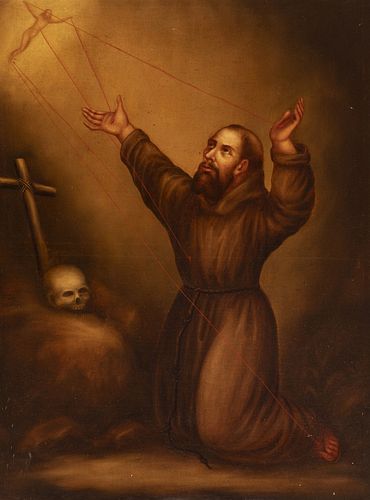Sevillian school, circa 1800. "St. Francis receiving the stigmata". Oil on canvas. Relined.
Lot 74
About Seller
Setdart Auction House
Carrer Aragó 346
Barcelona
Spain
Setdart Subastas was born in 2004 and is currently the first online art auction in Spain with solidity, prestige and reliability guaranteed by our more than 60,000 users. Setdart has a young, dynamic and enterprising team ready to successfully manage the purchase and sale of art works through custom...Read more
Estimate:
EUR€900 - EUR€1,200
$967.74 - $1,290.32
Absentee vs Live bid
Two ways to bid:
- Leave a max absentee bid and the platform will bid on your behalf up to your maximum bid during the live auction.
- Bid live during the auction and your bids will be submitted real-time to the auctioneer.
Bid Increments
| Price | Bid Increment |
|---|---|
| EUR€0 | EUR€10 |
| EUR€200 | EUR€25 |
| EUR€500 | EUR€50 |
| EUR€1,000 | EUR€100 |
| EUR€3,000 | EUR€200 |
| EUR€5,000 | EUR€500 |
| EUR€10,000 | EUR€1,000 |
| EUR€20,000 | EUR€2,000 |
| EUR€50,000 | EUR€5,000 |
About Auction
By Setdart Auction House
Nov 3, 2021
Set Reminder
2021-11-03 08:00:00
2021-11-03 08:00:00
America/New_York
Bidsquare
Bidsquare : OLD MASTERS
https://www.bidsquare.com/auctions/setdart-auction-house/old-masters-7786
Setdart Auction House sofia@setdart.com
Setdart Auction House sofia@setdart.com
- Lot Description
Sevillian school, circa 1800. "St. Francis receiving the stigmata". Oil on canvas. Relined. Presents period frame. Measurements: 83 x 63 cm; 92 x 71 cm (frame). The so-called "Stigmatization" took place in September 1224, on Mount Alvernia. St. Francis decided to have a hut built to isolate himself on that mountain, praying, with Friar Leon bringing him bread and water, a brother who witnessed several miracles, among which the one related in this work stands out. According to the narration of St. Bonaventure, the crucified Nazarene would have appeared to him, surrounded by six angelic wings, imprinting on the saint the signs of the Crucifixion on his hands, feet and side, wounds that he would keep for the rest of his life, trying to hide them from the sight of the people. St. Francis (Assisi, Italy, 1182 - 1226) was the son of a wealthy Italian merchant. Baptized as John, he soon became known as "Francesco" (the little Frenchman), because his mother came from that country. His youth was joyful and carefree until the age of twenty-five, when he changed completely and began to dedicate himself to the service of God, practicing the Gospel ideal: purity, detachment and joy in peace. Francesco renounces the great inheritance received from his parents and decides to live poorly, giving an example of authentic Christianity. He soon had several young disciples, called by the saint "order of the Friars Minor". In 1210, Pope Innocent III granted them the foundation of the new order and encouraged them in their evangelical tasks. During a retreat on the mountain, Christ appeared to him, and legend has it that from his wounds came rays that caused Francis various stigmata. He was a legendary character during his lifetime, considered a living relic. Likewise, his exquisite poetry and his familiarity with nature add the most human accent known in a saint, as can be seen in his "Canticle to the Sun".
- Shipping Info
-
In-house shipping available. Please inquire at admin@setdart.com.
-
- Buyer's Premium



 EUR
EUR CAD
CAD AUD
AUD GBP
GBP MXN
MXN HKD
HKD CNY
CNY MYR
MYR SEK
SEK SGD
SGD CHF
CHF THB
THB














